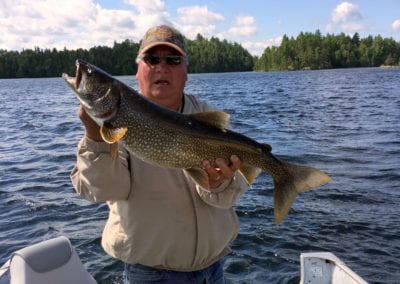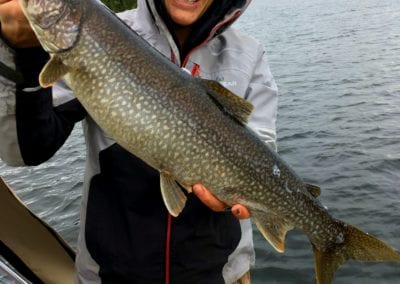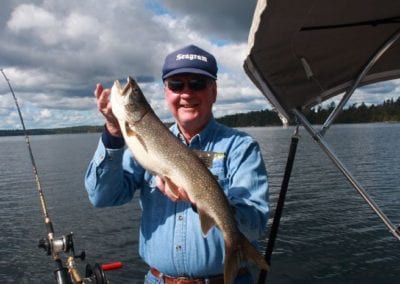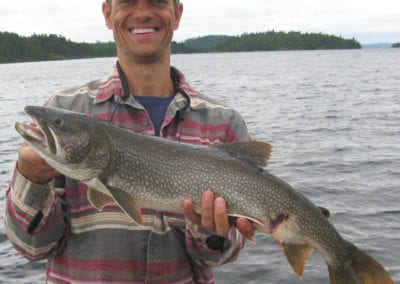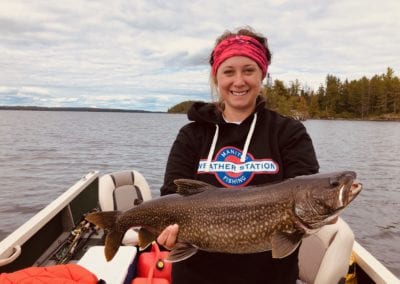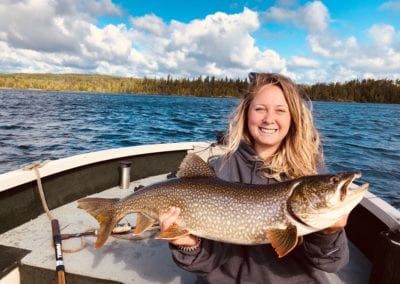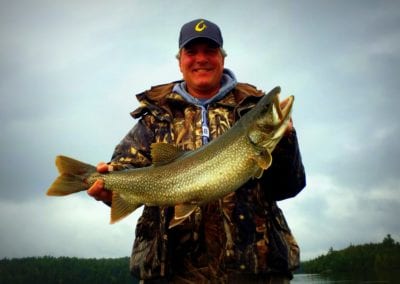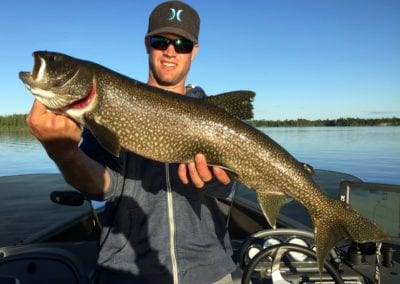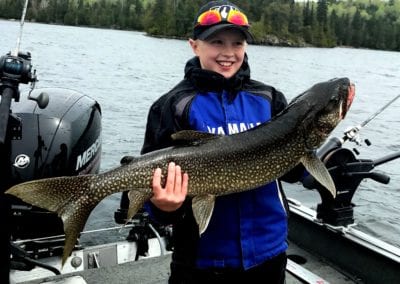Lake Trout Fishing
At The Manitou Weather Station
Trophy Lake Trout in Ontario Canada
Lake Trout Fishing
Muskie Fishing
Bass Fishing
Pike Fishing
Walleye Fishing
Ice Fishing
Trout Fishing at Manitou Lake
Lower Manitou Lake is absolutely one of the best Ontario Lake Trout lakes and boasts trout of all sizes. Our large numbers make it easy for you to catch smaller, good eaters right up to big, trophy/lunker Lake Trout every trip.
Our season starts off with ICE OUT trout fishing. If you haven’t tried our lake yet and you want to experience a trout frenzy, try fishing at ICE OUT. Just like the name says, ICE OUT fishing is the weekend right after the ice breaks up on the lake. One condition though is you have to tough out the unpredictable weather! During ICE OUT, in the spring, we have had guests catch their limit of trout in only a few minutes of fishing close to camp. This does not always happen, but schools of Lakers do swim along the shoreline in the spring. This is when the die-hards get their gear out for their first action of the season!
After ICE OUT, for the first 3 or 4 weeks, Lake Trout are shallow and very active. Using trout lures such as Rapala, Mepps #5 or bigger cowbell spoons, and sometimes tipped with either sucker, shiners or ciscos, guest have found success catching trout. Fly fisherman will have lots of exciting opportunities with a mix of flies. As the water warms up, trout slowly make their way deeper until mid-summer where they can be found from 30 to 100 feet deep, following schools of baitfish. By changing gear and moving to the right spots, trout can still be caught in great numbers. Proven trout techniques include using jigs, downriggers or trolling with a 3-way swivel rig. On other lakes, Lake Trout can be elusive during the summer. On Lower Manitou, they are easy to catch, and plentiful all season.
Trout are common in the 2 to 6-pound range. Frequently we have guests bring in Lake Trout between 8 and 15 pounds. Occasionally trout in the 20 to 30-pound range are caught. Lower Manitou Lake is a big lake so there should be plenty of trout over 30 pounds. A trout that lives long enough to weigh 30 pounds is smart, so you can’t expect it to make a mistake and hit a lure too often.
Lake Trout are very sensitive to changes in atmospheric pressure. When they are feeding, which is usually for 2 or 3 hours at a time, you can catch 5 to 30 trout within a time period. Some days they are not feeding, so it does not matter where or how you fish. If you have experience with Lake Trout, then you know what we mean. One thing is for sure; there are very few lakes in Ontario with Lake Trout fishing as fantastic as the trout fishing on Lower Manitou.
Lower Manitou Lake is a crystal clean lake with a diverse rocky structure including many islands, shoals, deep ridges, sunken plateaus and even deep weed beds. It’s also a nutrient rich lake with massive schools of baitfish. The reason the lake is clear is because it has deep holes that consume all the sediments. There is a large forage base of baitfish because of mineral deposits in the area. Glaciers scraping the land and exposing non-porous Precambrian Rock formed most Canadian Shield Lakes. Lower Manitou Lake was formed the same way, but we are lucky that large amounts of minerals were deposited.
A precious mineral to the fish is calcium. The population of fish cannot exceed the calcium content of the water because they need it to grow bones. Our lake has a very healthy amount of dissolved calcium thus having a bountiful amount of natural resources for trout to proliferate in great numbers and grow large. This holds true with Muskie, Pike and Smallmouth Bass.
Lower Manitou Lake has perfect environmental conditions for fishing Northwest Ontario Lake Trout. It’s something our guests enjoy immensely. Be sure to rent a fishing boat for lake trout fishing while here, or book one of our experienced fishing guides to find big lake trout!
Ontario Lake Trout Fishing Tips
The 3-way swivel technique below is ten times better then using steel line or bait-walkers, and it’s a lot more fun than using down-riggers. All you need is your Walleye Stick. You need a light action rod with 6-pound test line, or 8-pound ultra thin braided line. You also need three-way swivels and a 1 or 2-oz weight depending how deep you want to fish, which depends on what time of year it is.
Diagram Showing the Setup:
By using light line, the line has less friction with the water and slices through so that your line goes down to the bottom without having lots of line out. Tie two 3-foot pieces of line to your three-way swivel. Use a 1 or 2-oz. weight on one line and a light lure on the other. Lake Trout like small lures more than big lures. The very best lure is a small Sutton Silver Spoon. You can also use #1 or #0 Mepps, Panther Martins, Moose Spoons, tiny DareDevils, Nasty Boyz or Blue Foxes. Small Cleos or a small Mepps Cyclopes are also good but you have to shorten the lead line because these lures are heavy..
A 1-oz weight with 6-pound test dark green line is good for fishing down to 40 feet. A 2-oz weight is good for fishing down to 65 feet.
Trolling Slowly for Lake Trout:
You only want to move just fast enough for your lure to work, and no faster. If your boat is moving too fast, it will be very hard to find the bottom of the lake. If you are using a boat with a bigger motor and it’s hard to keep slow, try back trolling.
Finding the Bottom:
The most important aspect of deep water trout fishing is letting out line to get to the bottom. DO NOT JUST LET YOUR LINE OUT UNTIL IT HITS BOTTOM. Hold the rod in one hand with the bail open. Let the line run through the palm of your other hand and grip the line. Once the boat starts moving and you have a good straight troll going, open your hand with the line then close it again. This way you can let out a foot or two of line at a time. Get a rhythm going. Open, close, open, close. Your rod tip will bounce up and down as you release little bits of line. The rhythm of your rod tip bouncing will be disrupted when your weight hits the bottom of the lake. When this happens, reel up a foot or two. The purpose of this procedure is to keep your 3-way swivel setup from getting tangled.
Trout are funny when it comes to hitting your lure. Small ones hit and then take off – you know you have a fish on. Really big trout hit the lure and slowly swim away, some don’t know they’re hooked. If you think you have a snag, make sure it’s not a fish before you start tugging on your line. If it’s a big trout, loosen the reel drag because they will go nuts and strip 100 feet of line off your reel before you can turn them. Keep your drag set for 6-pound test line and do not horse it in.
Lake Trout & Weather:
In the summer time, Ontario Lake Trout hit best in the morning between first light and 10:30 AM. They will hit better if the surface of the water is dead calm and it’s a clear sky with high pressure. Any other conditions will cause them to slow down. In early spring trout seem to feed in other parts of the day. In some lakes the trout feed aggressively before dark.
Lake Trout Structure and wind:
Take a close look at the structure of the shoreline and try to extend the elevation patterns into the lake. If you see a cliff, odds are the water is deep at its face. If you see a string of islands, odds are there is a shallow shoal that runs between them. Trout like drop-offs so you want to troll parallel to the string of shoals and not over them.
When you drop your line to the bottom, count how many times you let out line. You can get a good estimate of the depth. For Lake Trout, try to stay in 30 to 60 feet of water and close to shore. If you come across a spot and catch a trout, odds are there are more of them there.
The wind is very important when trout fishing. Traditionally for warm water fish like Walleye or Pike, you would fish on the side of the lake were the wind is blowing. The logic being that the fish follow the surface food that is being blown in. With trout it’s the exact opposite. The wind also blows the warm surface water, which does not hold enough oxygen for the trout. Thus fish the side of the lake where the wind is coming from.
There will be Lake Trout out in the middle of the lake suspended 40 to 60-feet down. They are usually in close proximity to schools of bait-fish. If you are closer to shore in 40 to 60-feet of water and not catching anything, drop your line down to the bottom so you know how deep you are and then leave your rig at that depth and head out into open water. In open water, you will usually catch less trout but they will be bigger. There are occasions where all trout are out in the open water, especially when the last few days have been hot with strong variable winds.
Lake Trout Depth:
In the spring, Lake Trout will be right up to the surface. As the water starts to warm up with the changing weather, trout start to go deeper. This is not true for all lakes. Some smaller spring-fed lakes have trout in shallow water all year. Here are approximate depths for different times of year:
Just after ice-out: Between 10 feet and the surface
Mid Spring: About 20 to 30 feet deep
Late Spring: About 30 to 45 feet deep
Summer: Summer is tricky. Many believe that Lake Trout go to the deepest part of the lake and stay dormant. In actual fact, Lake Trout stay suspended in 53° thermal layers or concentrate in shallower holes where a natural spring pumps cold water into the lake. Why are they there? That’s where all the baitfish are. There will be trout deeper then 60 feet or on the bottom in the deepest part of the lake but they are not feeding. When they do feed, they come shallower.
Depth Finder:
It’s good to have a depth finder so you can map the schools of bait-fish that are suspended. When you do come across a school, troll around the outside of the school. The Lake Trout sit right underneath the school waiting for weak or injured fish to venture outside the school. Out in the middle of the lake, you will find these schools of bait-fish in the 30 to 60-foot range. It’s different on most lakes but this is a good place to start.
Middle of Summer Lake Trout:
The middle of summer is the time when people spend the least amount of time hunting down Lake Trout. With the 3-way swivel method, the middle of the summer can be the best time because the Lakers are concentrated in the deep holes and not spread out all over the lake like they are in the spring. Once you find a spot in the summer where you are catching Lake Trout, keep going back because they will stay in the same spot the whole summer.
A Lake Trout’s feeding turns on and off like a light-switch. You can find a spot where you are mapping fish on your depth finder and fish that spot for days without catching anything. Then all of a sudden, they start feeding like crazy for an hour or two and then stop dead again. You have to keep trying. Perseverance is a major factor in successful Lake Trout fishing.
Learn more about our rental fishing boats here and see our photo gallery of fishing boats.
Top Ontario LAKE TROUT Lures
- Little Cleos
- Mepps Cyclops
- Mepp’s Long-Cast Spinners
- Dardevle Spoons (Yes, the proper spelling is Dardevle®, not DareDevil)
- Johnson Silver Minnow
- Krocodiles
- Original Floating Rapalas
- Junior Thundersticks

